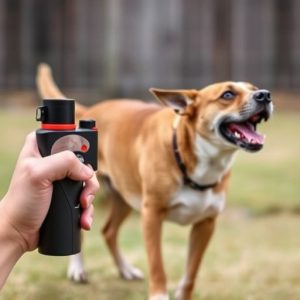Mace Dog Spray Range: Maximizing Effectiveness & Safety for Pets
Mace dog spray, using capsaicin and oleoresin capsicum from chili peppers, irritates sensitive areas…….
Mace dog spray, using capsaicin and oleoresin capsicum from chili peppers, irritates sensitive areas to temporarily neutralize aggressive dogs. Effective application targets high-sensitivity zones like eyes, nose, and paws, but responsible use is key after exhausting training methods. Understanding the spray's effective distance (2-3 feet) depends on product specifics, environmental conditions, and user technique. Neutralize pet skin by spraying short bursts from 2-3 feet away, targeting sensitive areas, while wearing protective gear. After exposure, rinse the affected area with warm water for 15 minutes, gently dry without rubbing, and monitor your pet for discomfort or irritation.
“Uncover the power of mace dog spray: a powerful tool for neutralizing aggressive canines. This comprehensive guide explores the science behind its active ingredients and their effects, delving into the critical factor of effective distance. We’ll dissect the variables that impact spray range, providing practical application techniques to ensure optimal coverage and safety. Additionally, learn essential post-exposure care steps to effectively clean and soothe your pet’s skin after mace contact.”
- Understanding Mace Dog Spray: Active Ingredients and Their Effects
- Determining Effective Distance: Factors Influencing Spray Range
- Application Techniques to Maximize Coverage and Safety
- Post-Exposure Care: Cleaning Pet Skin After Mace Contact
Understanding Mace Dog Spray: Active Ingredients and Their Effects
Mace dog spray is designed to neutralize and deter aggressive dogs by exploiting their sensitive senses. The active ingredients in these sprays typically include capsaicin, oleoresin capsicum, and various aromatic compounds. Capsaicin, commonly found in chili peppers, irritates the eyes, nose, and throat, causing the dog to experience discomfort and temporarily reduce its aggression. Oleoresin capsicum, derived from chili peppers as well, amplifies these effects by targeting the pain receptors in a dog’s sensory system.
When applied to a dog’s skin, these sprays create an unpleasant experience that quickly neutralizes their behavior. However, understanding how and where to apply the spray is crucial for its effectiveness. Concentrating on areas like the face and paws, which are highly sensitive, can ensure the quickest response. It’s important to note that while mace dog spray is potent, it should be used responsibly and only as a last resort when other training methods have been exhausted. Always follow safety guidelines and consider consulting with a professional trainer for proper usage techniques aimed at neutralizing mace spray on pet skin.
Determining Effective Distance: Factors Influencing Spray Range
Determining the effective distance of dog spray, like that from a mace canister, involves understanding several factors. The range can vary significantly based on the specific product, environmental conditions, and application method. For instance, wind direction and speed can greatly affect how far the spray travels; headwinds may enhance reach while tailwinds could limit it. Factors related to the user’s technique, such as spraying at an angle or from a distance, also play a role in maximizing or minimizing coverage. Moreover, the neutralizing effect on pet skin is a key consideration—canister design and the type of chemical agents used determine how quickly and effectively the spray deactivates potential threats, ensuring both safety and control during encounters.
Application Techniques to Maximize Coverage and Safety
To maximize the effectiveness of neutralizing mace dog spray, proper application techniques are crucial. First, ensure even distribution by spraying in short bursts from a distance of 2-3 feet, allowing the mist to settle before applying more. This method helps prevent overspray onto nearby surfaces or other animals. Additionally, target specific areas like the face and paws, where mace spray can quickly be absorbed into sensitive skin, ensuring deeper penetration for faster neutralization.
When applying mace spray on pet skin, caution is paramount. Always wear protective gear, including gloves and a mask, to prevent direct contact with chemicals. Hold the nozzle away from your body and aim carefully, avoiding eyes, nose, and mouth not only for safety but also to ensure effective neutralization of the spray. Regularly inspect and maintain your mace device to guarantee optimal performance when needed.
Post-Exposure Care: Cleaning Pet Skin After Mace Contact
After an exposure to mace dog spray, proper post-exposure care is crucial to ensure your pet’s skin is neutralized and any potential irritation or damage is minimized. The first step is to immediately rinse the affected area with warm water for at least 15 minutes. This helps to flush out any remaining spray chemicals. It’s important to be thorough, making sure all visible liquid is removed from the skin.
Next, gently dry the pet’s skin using a soft towel. Avoid rubbing, as this can exacerbate irritation. If there is any residual spray or irritation, consider using a mild, pH-balanced shampoo recommended by your veterinarian. Rinse thoroughly again to ensure no soap residue remains. Always monitor your pet for signs of discomfort or persistent irritation after cleaning and seek veterinary advice if needed.
Mace dog spray can be an effective tool for neutralizing aggressive dogs, but understanding its active ingredients, application techniques, and safety measures is crucial. By knowing the factors influencing the spray’s range and proper application methods, pet owners can ensure maximum coverage while minimizing risks. After exposure, promptly cleaning pet skin with water and mild soap helps to neutralize any remaining spray, making it a vital step in post-exposure care.


